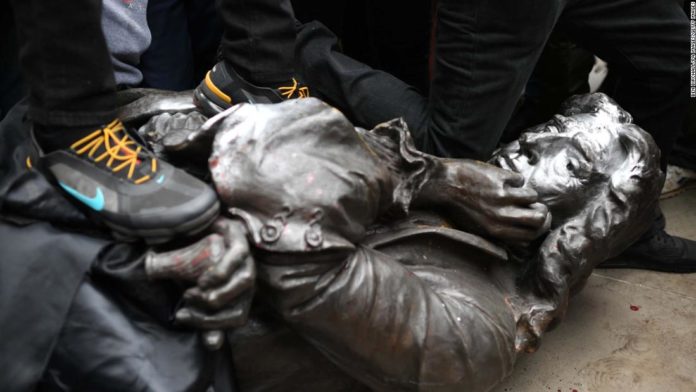Some applauded the move, while others decried what they called “mob rule.”
For some, the statues have melted into the background of daily life, but many people are now questioning whether they should still stand on their pedestals.
On Tuesday, the Mayor of London, Sadiq Khan, announced a commission to examine the future of landmarks around the UK capital, including murals, street art, street names and statues.
The Commission for Diversity in the Public Realm is aimed at improving “diversity across London’s public realm, to ensure the capital’s landmarks suitably reflect London’s achievements and diversity.”
While these actions have divided public opinion, they feed into a growing conversation about what should happen to statues of individuals like Colston, who profited from the suffering of so many.
Winston Churchill
A statue of Winston Churchill in London’s Parliament Square is seen defaced with the words “was a racist” written after his name, following a Black Lives Matter demonstration on June 7, 2020. Credit: Isabel Infantes/AFP/Getty Images
During Sunday’s Black Lives Matter protest, a statue of Churchill standing in London’s Parliament Square was daubed with the words “… is a racist.”
Cecil Rhodes

Oriel College has so far kept this statue of Cecil Rhodes despite an ongoing campaign for its removal. Credit: Carl Court/Getty Images
Cecil Rhodes, who helped build Britain’s empire in southern Africa, is immortalized in a statue outside Oriel College, part of the University of Oxford.
Neither Oxford University nor Oriel College responded to CNN’s request for comment.
In 2015, a statue of Rhodes was removed from the campus of the University of Cape Town in South Africa.
“He represents the former colonial representation of this country — supremacy, racism, misogyny,” said Ramabina Mahapa, president of the student group that led the campaign to remove the statue, at the time.
David Hume

A placard was placed in protest on a statue of Scottish Enlightenment philosopher David Hume, decrying his racist views. Credit: jpi media
In Edinburgh, a statue of the 18th-century Scottish philosopher David Hume was adorned with a placard quoting his views on white superiority.
Hume is considered one of the foremost thinkers of the Scottish Enlightenment, and his bronze statue sits on Edinburgh’s Royal Mile, the main thoroughfare of the city’s Old Town.
But Hume’s reputation has become tarnished in recent years, with increased focus on his views on race. The sign left on the statue features a line from Hume’s essay “Of National Characters” saying that he “is apt to to suspect the negroes … to be naturally inferior to the whites.”

Nelson’s Column, topped by a statue of Admiral Horatio Nelson, towers over Trafalgar Square in Central London. Credit: evenfh/Shutterstock
Henry Dundas
A statue of Scottish politician Henry Dundas stands atop the Melville Monument in the city of Edinburgh.
Dundas, who held a number of government positions, including Home Secretary, is known for supporting the delay of the abolition of slavery towards the end of the 18th century.
Campaigners are instead recommending that the streets be named after Scottish-Jamaican slave Joseph Knight, who successfully freed himself in the courts by proving that Scots law did not recognize slavery.
Different approaches

William Gladstone served as British Prime Minister four times in the 19th century. His father owned slaves. Credit: View Pictures/Universal Images Group/Getty Images
Tearing down statues is a time-honored form of protest, from the toppling of statues of Lenin when the Soviet Union collapsed in 1989 to the fall of Saddam Hussein’s monument in Baghdad in 2003.
These instances of destruction were widely applauded in the Western world, but recent campaigns to remove statues of controversial figures in places like the US and UK have divided public opinion.
An alternative approach was taken in Paraguay, where artist Carlos Colombino was asked to reimagine a statue of former dictator General Alfredo Stroessner, who ruled the country from 1954 to 1989. Instead of simply destroying the monument, Colombino encased some of its most recognizable parts between two huge blocks of cement as a memorial to victims of the dictatorship.
Source : Nbcnewyork












